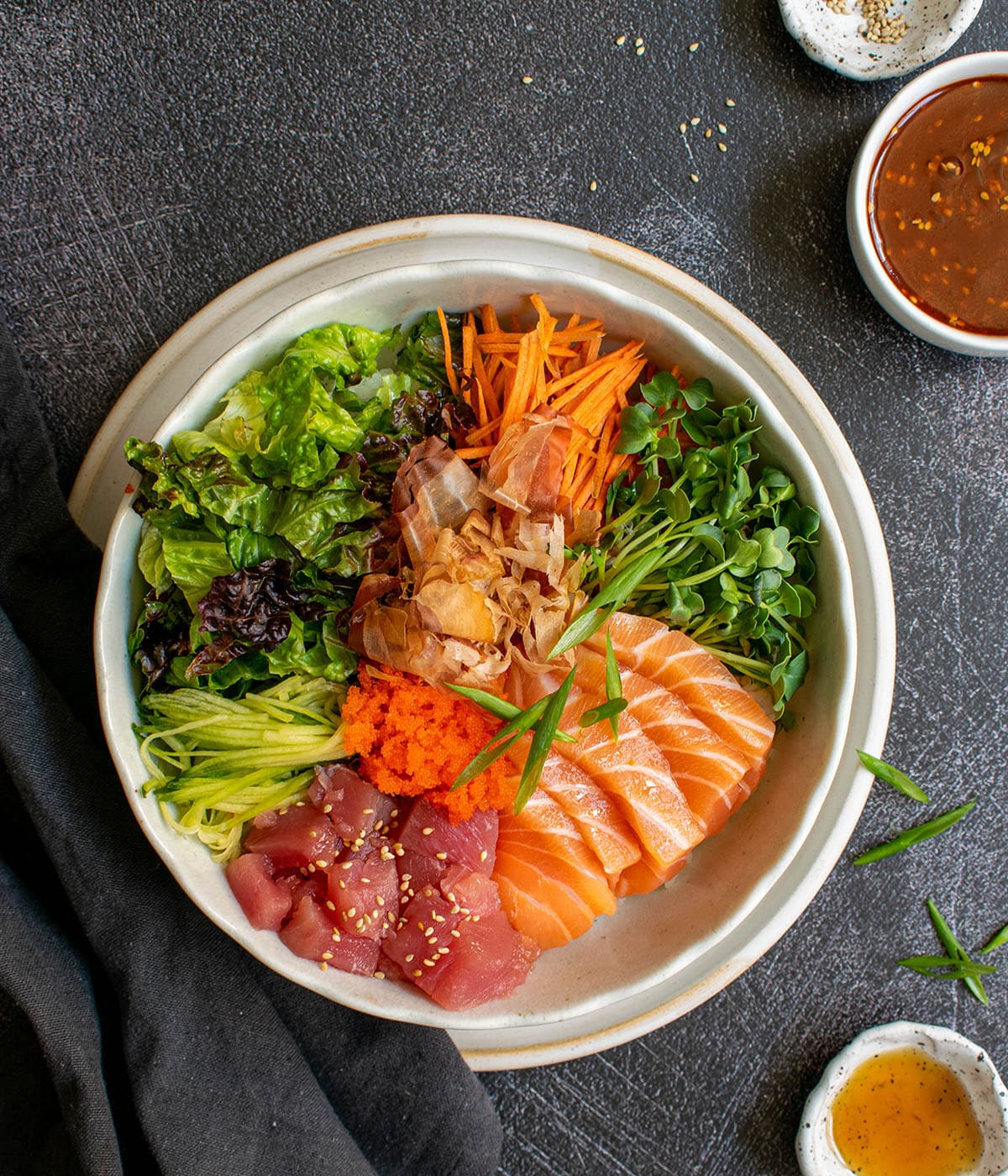Hwe dup bap is the sushi bowl you didn't know you needed in your life. This Korean dish dresses up the rice bowl with a spicy gochujang sauce that brings the perfect kick.


Jump to:
Watch how to make this
What makes this dish special
Ever since I got back from my trip to Japan, I have never had the desire to eat sushi anymore. The fish at home is nowhere as fresh as the ones in Toyko and doesn't seem worth the price. The only sushi dish I occasionally crave is the Korean sushi rice bowl, hwe dup bap. It wasn't until my high school days that my mom introduced me to this dish, but I haven't turned back since.
Think of it as a deconstructed sushi bowl but with a special spicy sauce. If you ever had the Korean rice bowl, bibimbab, or this spicy Korean chicken bowl, and are a fan of sushi, this dish is for you. And if you're looking for another delicious sushi bowl, try this baked salmon sushi bowl!
Ingredients

- Rice: Short-grain or medium-grain rice is best for this dish.
- Salmon: Use sushi-grade salmon for best results.
- Tuna: Use sushi-grade tuna for best results.
- Masago: A type of small fish roe with a slightly sweet and salty taste. You can substitute it with tobiko if desired.
- Bonito Flakes: Thin shavings of dried, smoked bonito fish, bonito flakes add umami to the dish but can be omitted.
- Radish Sprouts: Delicate and slightly peppery shoots. If you can't find radish sprouts, omit them or replace them with extra salad greens or perilla leaves for an earthy flavor.
- Gochujang: A spicy Korean chili paste. Find it in almost any Asian market.
Substitutions and variations
- Protein: Other fresh fish options include snapper, albacore, and yellowtail. You can also venture out and add tamago, ikura, or poached shrimp.
- Other vegetables: Experiment with adding other vegetables and toppings such as bibb lettuce, romaine, gem lettuce, or even mesclun greens. You can also add perilla leaves, nori strips, or thinly sliced jalapeno peppers for an extra kick!
Step-by-step instructions
Step 1: Prepare the ingredients
Start by cooking your rice. The rice should still be warm when you assemble the bowls, but not piping hot. There's no need to season the rice like when you make sushi, but you can if you want a little extra flavor.

While the rice is cooking, prepare the vegetables. Chop the red leaf lettuce and thinly slice carrots and cucumbers. I used a mandoline to get the vegetables thin enough.
Slice the seafood, slicing or chopping the fish into bite-size pieces. You can also freeze the seafood for an hour beforehand to make it easier to slice.
Step 2: Assemble
Now it's time to assemble! Divide the rice into two large bowls, about 1 cup per serving. Arrange the red leaf lettuce, carrots, cucumber, and radish sprouts evenly on top of each bowl. Then, arrange the sliced salmon and tuna on top.

Step 3: Garnish
Although the hwe dub bap would be good just as is, we're going to make it extra tasty with special toppings. Adding ingredients like masago, scallions, sesame seeds, and bonito flakes takes this bowl from a home-style bowl to restaurant-quality. I refuse to eat hwe dup bap without masago and bonito flakes - it makes all the difference. If you want to even more toppings, add nori strips, salmon roe, or even pickled ginger.

Finish your bowl with the spicy sauce and a drizzle of sesame oil, mix everything together, and enjoy! With the craze of poke bowl restaurants popping up left and right, I predict that hwe dup bap will be next - or at least they should be!

Make-ahead and storage
- Make-ahead: You can make the spicy sauce and prepare all of the toppings beforehand. Since you are consuming raw fish, it's best to prepare the dish right before serving or a few hours before. If preparing ahead of time, make sure to keep the dish chilled until serving.
- Storage: Keep leftover assembled hwe dub bab in airtight containers and keep them in the fridge for up to 1 day.
Frequently asked questions
Instead of red leaf lettuce, you can use any other leafy green such as bibb lettuce, romaine, gem lettuce, or even mesclun greens. You can also add perilla leaves, nori strips, ikura, or thinly sliced jalapeno peppers for an extra kick!
Yes, you can skip the gochujang spicy sauce and drizzle sesame oil and a bit of soy sauce, if desired.
I locate mine at my local Asian market but you can also try Japanese grocery stores, specialty seafood markets, or even sushi restaurants.

More rice bowl recipes
Looking for more rice bowl ideas? Try these:
Recipe
Hwe Dup Bap (Korean Sushi Bowl)
Ingredients
Spicy sauce
- ¼ cup gochujang
- 1 tablespoon water
- 1 teaspoon granulated sugar
- 1 teaspoon sesame oil
- 1 teaspoon sesame seeds
Remaining ingredients
- 2 cups cooked short-grain white rice
- 2 cups red leaf lettuce chopped
- 1 large carrot thinly sliced
- 1 persian cucumber thinly sliced
- ¼ cup radish sprouts
- 4 ounces sashimi grade salmon
- 4 ounces sashimi grade tuna
- 2 tablespoons masago
- 1 tablespoon toasted sesame seeds
- 2 tablespoons chopped green onions
- ¼ cup bonito flakes
- 1 tablespoon sesame oil
Instructions
- Combine ingredients for the spicy sauce, mixing together until incorporated. Set aside.
- Assemble bowls. Place 1 cup rice in the bottom of a large bowl and top with red leaf lettuce, carrots, cucumber, radish sprouts, salmon, tuna, and masago. Garnish with sesame seeds, green onions, and bonito flakes. Drizzle sesame oil on top and add as much spicy sauce as you would like. Mix well and enjoy.











Mary Frances
Sushi is perfect for the summer! Love this 🙂
cma0425
Couldn't agree with you more!